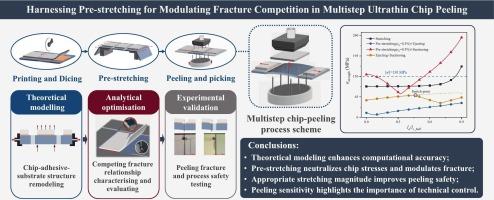Harnessing pre-stretching for modulating fracture competition in multistep ultrathin chip peeling
IF 3.8
3区 工程技术
Q1 MECHANICS
International Journal of Solids and Structures
Pub Date : 2025-08-07
DOI:10.1016/j.ijsolstr.2025.113597
引用次数: 0
Abstract
In the backend process of chip manufacturing, due to the highly dense arrangement of chips after wafer dicing, stretching pretreatment for spacing expansion is essential prior to chip-peeling stage. This study quantitatively integrated substrate pre-stretching step with chip-peeling techniques (needle ejection and vacuum suction), performing a mechanical analysis to develop parameterised optimisation for a multistep process. A non-equal-length laminated Timoshenko beam was modelled for the chip–adhesive–substrate (CAS) structure, particularly considering the transmission relationship of pre-stretching and its impact on structural deformation thorough the multistep process. Closed-form solutions for the delamination modelling were derived analytically and validated through finite element analysis. A dimensionless index was proposed to compare chip-peeling safety under different procedure combinations, and comprehensively evaluate the fracture competition. Appropriate pre-stretching was found to mitigate chip failure by neutralising stress fields and alter adhesive fracture by modulating the energy aggregation modes during delamination, and the optimal value of pre-stretching was established. The crack propagation sensitivity to load response hysteresis was assessed, illustrating that the optimised process required careful management of technical efficiency to ensure production safety. The multistep chip-peeling optimisation was validated experimentally, providing effective suggestions for manufacturing technology.

利用预拉伸调节多步超薄薄片剥离中的断裂竞争
在芯片制造的后端工艺中,由于晶圆切割后的芯片排列非常密集,因此在剥屑阶段之前,必须进行拉伸预处理以扩大间距。本研究定量集成了基材预拉伸步骤和切屑剥离技术(针顶出和真空抽吸),进行了力学分析,为多步骤工艺开发了参数化优化。针对CAS (chip-adhesive-substrate)结构建立了非等长层合Timoshenko梁模型,特别考虑了预拉伸的传递关系及其对结构变形的影响。推导了分层模型的解析解,并通过有限元分析进行了验证。提出了一种无量纲指标来比较不同工序组合下切屑剥离的安全性,综合评价断裂竞争。发现适当的预拉伸可以通过中和应力场来减轻切屑破坏,通过调节分层过程中的能量聚集模式来改变胶粘剂断裂,并确定了预拉伸的最佳值。评估了裂纹扩展对载荷响应滞后的敏感性,说明优化过程需要仔细管理技术效率以确保生产安全。实验验证了多步切屑剥离优化,为制造工艺提供了有效的建议。
本文章由计算机程序翻译,如有差异,请以英文原文为准。
求助全文
约1分钟内获得全文
求助全文
来源期刊
CiteScore
6.70
自引率
8.30%
发文量
405
审稿时长
70 days
期刊介绍:
The International Journal of Solids and Structures has as its objective the publication and dissemination of original research in Mechanics of Solids and Structures as a field of Applied Science and Engineering. It fosters thus the exchange of ideas among workers in different parts of the world and also among workers who emphasize different aspects of the foundations and applications of the field.
Standing as it does at the cross-roads of Materials Science, Life Sciences, Mathematics, Physics and Engineering Design, the Mechanics of Solids and Structures is experiencing considerable growth as a result of recent technological advances. The Journal, by providing an international medium of communication, is encouraging this growth and is encompassing all aspects of the field from the more classical problems of structural analysis to mechanics of solids continually interacting with other media and including fracture, flow, wave propagation, heat transfer, thermal effects in solids, optimum design methods, model analysis, structural topology and numerical techniques. Interest extends to both inorganic and organic solids and structures.

 求助内容:
求助内容: 应助结果提醒方式:
应助结果提醒方式:


